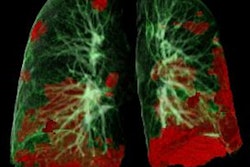
Extensive data and analysis about the full impact of COVID-19 on scanning volumes and workflow at a public hospital in Rome were released on 5 April in a European Radiology article.
 Prof. Andrea Laghi.
Prof. Andrea Laghi.During the first wave in March 2020, a 25% fall in radiologist workload was registered compared with the same period of 2019, but during the second wave in November 2020, no significant difference was seen, noted Prof. Andrea Laghi, head of radiology at Sant'Andrea University Hospital, and colleagues.
"Despite the significant reduction of about one-fifth of the total radiological exams (in the first wave), our radiology unit was able to increase by around 12% the number of CT exams for outpatients, particularly fragile and oncologic patients," they stated. "The risk of a simultaneous urgent case was balanced by the availability of a second backup CT in the main department, whose use did not affect the overall CT productivity."
Key challenges for radiology
The pandemic brought up two kinds of problems for radiologists: the diagnostic aspects that required specific training given the peculiarities of x-ray and CT findings of COVID-19 pneumonia, and the complex organizational difficulties.
Departments had to reorganize workload in a few days by taking critical decisions about the management of acute emergencies as well as those of chronic oncologic and fragile patients, explained Laghi, who is also professor of radiology at Sapienza University of Rome and a member of the editorial advisory board of AuntMinnieEurope.com.
Radiology's four most urgent priorities were the following:
- Creating separate pathways for COVID-19 and non-COVID-19 patients, to avoid cross contamination of patients
- Integrating a dedicated CT scanner in the COVID-19 pathway to improve diagnostic accuracy
- Involving staff in the emergency department, particularly for night shifts
- Guaranteeing diagnostic exams in frail and cancer patients
"Putting these organizational changes into practice in a sudden and precise way was extremely complex and particularly true for healthcare organizations who lack real-time information on workflows and on modifications brought on by unexpected external events," they added.
Stringent internal CT protocols were established, allowing scans of COVID-19 patients consecutively and safely while sanitizing the CT scanner room at the end of the shift and not after each single CT exam.
"Nevertheless, we had continuously monitored emergency room accesses to be alerting by any critical scenarios weekly, ensuring the right assistance for acute patients and avoiding any unjustified delays in diagnosis," the authors wrote.
Hospital facts and figures
Sant'Andrea University Hospital is a center of excellence for thoracic surgery, medical oncology, and orthopedic surgery with 452 beds, seven departments with 48 units, 523 doctors, and 1,063 healthcare professionals.
 A new building for teaching and research at the Faculty of Medicine and Psychology opened at Sant'Andrea Hospital in 2020. Photo courtesy of LaPresse/Alamy Stock Photo.
A new building for teaching and research at the Faculty of Medicine and Psychology opened at Sant'Andrea Hospital in 2020. Photo courtesy of LaPresse/Alamy Stock Photo.The radiology department comprises three subunits: interventional radiology, breast imaging and general radiology, and emergency radiology. The staff consists of 23 radiologists (4 dedicated to intervention), 38 residents, 41 radiographers, and 15 nurses. Three digital radiology units, two interventional radiology suites, two CT scanners, two 1.5-T MRI scanners, one musculoskeletal-dedicated low-field MR scanner, one ultrasound unit, one mammography machine, and one bone densitometry scanner are available in the main department.
The number of exams performed by modality are shown in the table below.
 Table courtesy of European Radiology.
Table courtesy of European Radiology.Overall, emergency radiology workload slightly increased (3.48 exams/h) compared with the first wave (+16%), but it was still well below the standards of 2019 (3.89 exams/h), thus justifying the decision to keep personnel allocation unchanged.
"Concerning the workload of my department in 2021, it is almost back to the figures of 2019: 115K vs 118.9K exams," Laghi noted in an email on 7 April. "We are currently working on a more detailed analysis."
Laghi and colleagues also reflected on what enabled them to cope during the pandemic.
"In times of crisis, resilience is a fundamental quality to possess. It allows for change to happen rapidly and smoothly," they concluded. "Business analytics software is an extremely powerful tool that provides a precise insight of real-time changing scenarios. When applied to our radiology unit, it allowed us to reinforce managerial decisions and to support the changes in workforce planning."



















